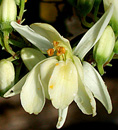 |
QUICK SEARCH
MO PROJECTS:
Africa
Asia/Pacific
Mesoamerica
North America
South America
General Taxonomy
Photo Essays
Training in Latin
America
MO RESEARCH:
Wm. L. Brown Center
Bryology
GIS
Graduate Studies
Research Experiences
for Undergraduates
Imaging Lab
Library
MBG Press
Publications
Climate Change
Catalog Fossil Plants
MO DATABASES:
W³MOST
Image Index
Rare Books
Angiosperm
Phylogeny
Res Botanica
All Databases
INFORMATION:
What's New?
People at MO
Visitor's Guide
Herbarium
Jobs & Fellowships
Symposium
Research Links
Site Map
Search
|
Draft Treatments | Guidelines | Checklist | Citing | Editors The Cutting EdgeVolume IX, Number 1, January 2002News and Notes | Leaps and Bounds | Germane Literature | Season's Pick SEASON'S PICK: Moringa oleifera 
 One country's panacea is another's fence-row ornamental. This season's pick, Moringa oleifera Lam. (Moringaceae) locally known as "Marango", although a non-native (southern foothills of the Himalayas) cultivated plant, fits the bill for flowering during December (INBio's database also shows it as having been collected in flower during February and June). Being restricted here, as far as we know, to certain fence-rows and yards on the Peninsula of Nicoya, does give it some floristic interest, especially since it might easily be mistaken by the casual drive-by observer as another common fence-row tree, Gliricidia sepium (Jacq.) Steud. (Fabaceae). Flora of Costa Rica) tells us that this plant is "commonly planted in hedges and also as an ornamental tree, often naturalized.... The flavor of the roots resembles that of horseradish (Armoracia; Rábano picante) .... Although planted in many parts of Central America, this tree is of quite ordinary appearance, its branches are easily broken, and it has little to recommend it." MO graduate Mark Olsen would disagree. For everything you might ever want to know about this small but interesting family, see his amiable Moringa Home Page. Furthermore, Manual collaborator José González (INBio) and accumulator of information about medicinal and other uses of plants sent us this list for Moringa oleifera as reported (http://ars-genome.cornell.edu/botany.html) from various countries, other than Costa Rica: adenopatía, dolores de oido, ascitis, asma, calvicie, catarros, cólera, hidropesía, dispepsia, disuria, epilepsia, erisipela, fiebre, cálculos renales, gota, hematuria, histeria, locura, neuralgia, paralisis, neumonía, reumatismo, sarna, escorbuto, espasmos, esplenitis, sífilis, tumores, dolores dentales, úlceras, convulsiones, vertigo, dermatosis, enteritis, dolores de cabeza, gonorrea, hemorroides, entumecimientos, ebriedad, como antidoto, bactericida, tónico cardiaco, refresco, diurético, emético, purgativo, rubefaciente, estimulante, vermífugo, vejigatorio, condimento, emenagogo, depurativo, expectorante y como enjuague para el cabello Well, OK, but we still appreciate Standley for his frankness. Photo credits go to Barry Hammel. |
© 1995-2025 Missouri Botanical Garden, All Rights Reserved
4344 Shaw Blvd.
St. Louis, MO 63110
(314) 577-5100
Technical Support